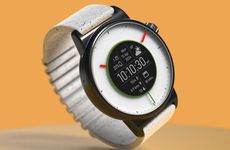MIT researchers have developed a prototype for a wearable navigation system that can guide people with visual impairments. The device is to be wrapped around the users chest and uses a 3D depth-sensing camera to alert wearers of obstructions in their path through an electronic braille pad. The braille pad helps provide context for the users, informing them of the specifics of the object through a simple labeling system that recognizes tables as 't' or chairs as 'c.'
The device, which frees users from having to use a cane, offers an added dimension of protection and independence among the visually impaired community. The technology uses haptic sensors to help the wearer observe their surroundings, enhancing mobility and autonomy.
Wearable Navigation Systems
This Wearable Device Can Guide People with Visual Impairments
Trend Themes
1. Wearable Navigation Systems for Visual Impairments - The development of wearable navigation systems for visually impaired individuals presents a disruptive innovation opportunity to improve their mobility and independence.
2. 3D Depth-sensing Cameras for Object Detection - The integration of 3D depth-sensing cameras in wearable devices opens up possibilities for disruptive innovation in object detection technology, benefiting various industries.
3. Haptic Sensors for Observing Surroundings - The use of haptic sensors in navigation systems creates a disruptive innovation opportunity to enhance sensory perception and improve mobility for individuals with visual impairments.
Industry Implications
1. Assistive Technology Industry - The development of wearable navigation systems presents disruptive innovation opportunities in the assistive technology industry, improving accessibility for visually impaired individuals.
2. Healthcare Industry - The integration of 3D depth-sensing cameras in wearable navigation systems offers disruptive innovation opportunities in the healthcare industry to assist visually impaired patients and improve their quality of life.
3. Technology Industry - The use of haptic sensors for observing surroundings presents disruptive innovation opportunities within the technology industry, enabling advancements in navigation systems and wearable devices.



